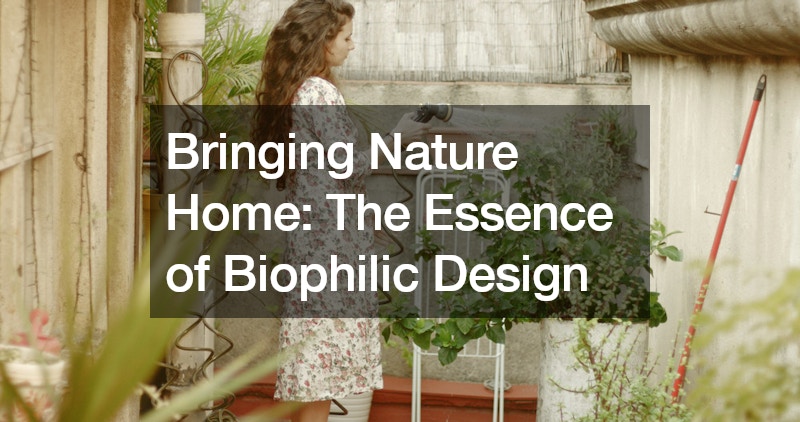In our fast-paced, modern lives, it’s easy to find ourselves disconnected from the natural world. We spend the majority of our days indoors, whether at work, school, or home, rarely stepping outside to breathe in the fresh air or feel the sun on our faces. However, there’s an inherent love for nature within us, a longing to connect with the environment around us. Biophilic design offers a solution, allowing us to bring the beauty and serenity of nature into our homes.
Lights and Air
One of the fundamental principles of biophilic design is the incorporation of natural light and air into living spaces. Incorporating natural light and air not only enhances the aesthetic appeal of a space but also contributes to our overall well-being.
The influx of sunlight infuses the environment with warmth and vitality, uplifting our spirits and enhancing our mood. Meanwhile, the circulation of fresh air promotes a sense of rejuvenation and vitality, invigorating both body and mind.
The incorporation of natural light and air into living spaces can be achieved through strategically placed windows and skylights that allow sunlight to flood the room and fresh air to circulate. The changing patterns of daylight and the gentle breeze can create a sense of connection to the outdoors, reminding us of the passage of time and the ever-changing seasons.
Vegetation
Plants play a multifaceted role in biophilic design, offering not only aesthetic appeal but also tangible benefits for our well-being. Their remarkable ability to reduce stress and improve air quality makes them an indispensable element of biophilic interiors and exteriors alike.
Indoor spaces come alive with the presence of abundant greenery. From delicate ferns to towering palms, incorporating a diverse array of plants adds depth and texture to the environment. A simple potted plant on a windowsill can breathe new life into a room, while a lush vertical garden serves as a striking focal point.
Water
The soothing sound of running water has a calming effect on the mind and body, making water features an ideal addition to biophilic design. Whether it’s the tranquil trickle of a stream or the soft splash of a fountain, these water features create an oasis of peace within the home, providing a sanctuary from the hustle and bustle of everyday life.
Living in proximity to bodies of water, such as rivers or lakes, offers an additional dimension to biophilic design, providing stunning vistas and an enhanced connection to the natural world. The calming presence of water not only adds visual interest to the landscape but also serves as a source of inspiration and rejuvenation. Whether it’s enjoying leisurely walks along the waterfront or simply gazing out at the shimmering expanse, the proximity to water fosters a profound appreciation for the beauty and tranquility of the natural world.
Natural Materials and Colors
Choosing materials and colors inspired by nature is another key aspect of biophilic design. From rich hardwoods to earthy tones, these elements bring warmth and texture to a space, evoking the natural beauty of the outdoors.
Timber, stone, and other organic materials not only add visual interest but also create a sense of authenticity and timelessness that artificial materials cannot replicate. Additionally, incorporating tropical wall decoration can infuse the space with vibrant colors and exotic patterns, further enhancing the tropical ambiance and connection to nature.
Patina
Embracing the natural aging process of materials is a philosophy rooted in biophilic design. Rather than striving for perfection, allowing materials to develop a patina over time adds character and charm to a home. Weathered wood, aged metal, and worn stone tell a story of the passage of time, reminding us of the beauty found in imperfection.
Outdoor Space
Creating functional outdoor spaces that seamlessly blend with the natural landscape is essential for biophilic design. Courtyards, gardens, and green roofs offer opportunities to reconnect with nature and extend living areas beyond the confines of the home. By minimizing the footprint of the house and maximizing outdoor space, we can foster a deeper appreciation for the environment and reduce our impact on the planet.
Relationship to Place
Perhaps the most important principle of biophilic design is establishing a strong relationship to the local environment. By incorporating indigenous flora, utilizing local resources, and embracing vernacular architecture, homes can become an integral part of their surroundings. This sense of place not only honors the unique characteristics of the region but also fosters a deeper connection to the land and its inhabitants.
In conclusion, biophilic design offers a holistic approach to creating living spaces that nourish the mind, body, and soul. By incorporating elements inspired by nature, we can transform our homes into sanctuaries that reflect our innate desire to connect with the natural world. From natural light and vegetation to water features and outdoor spaces, biophilic design has the power to enhance our well-being and bring us closer to the essence of nature.
.

